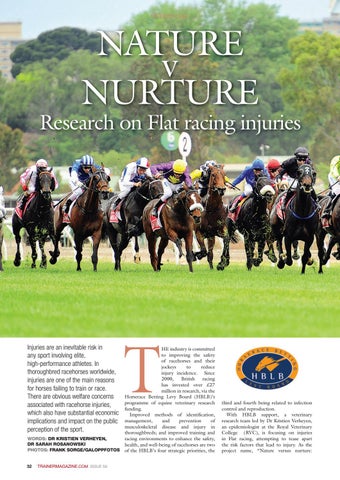VeterinarY
nature v nurture
research on flat racing injuries
Injuries are an inevitable risk in any sport involving elite, high-performance athletes. In thoroughbred racehorses worldwide, injuries are one of the main reasons for horses failing to train or race. There are obvious welfare concerns associated with racehorse injuries, which also have substantial economic implications and impact on the public perception of the sport.
t
He industry is committed to improving the safety of racehorses and their jockeys to reduce injury incidence. since 2000, British racing has invested over £27 million in research, via the Horserace Betting levy Board (HBlB)’s programme of equine veterinary research funding. improved methods of identification, management, and prevention of musculoskeletal disease and injury in thoroughbreds; and improved training and WORDS: DR KRISTIEN VERHEYEN, racing environments to enhance the safety, DR SARAH ROSANOWSKI health, and well-being of racehorses are two PHOTOS: FRANK SORGE/GALOPPFOTOS of the HBlB’s four strategic priorities, the 32
TRAINERMAGAZINE.COM ISSUE 50
third and fourth being related to infection control and reproduction. With HBlB support, a veterinary research team led by Dr Kristien Verheyen, an epidemiologist at the royal Veterinary College (rVC), is focusing on injuries in flat racing, attempting to tease apart the risk factors that lead to injury. as the project name, “nature versus nurture:
